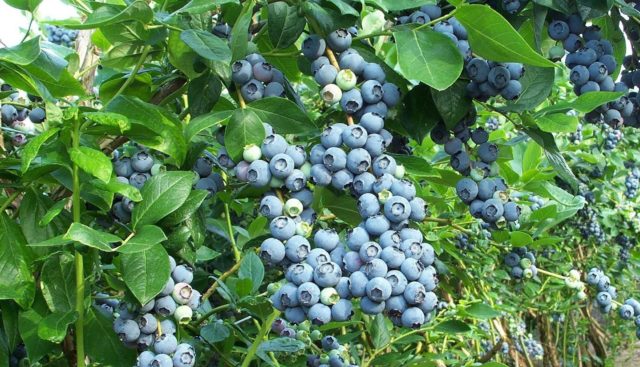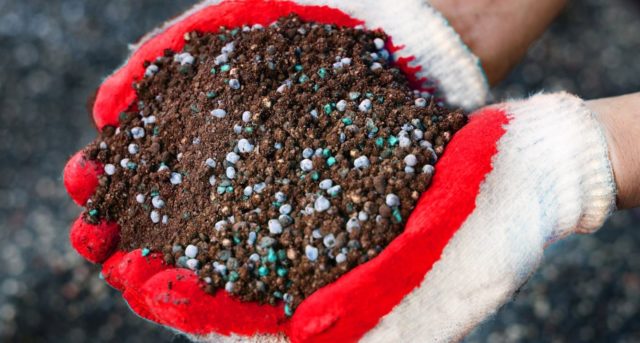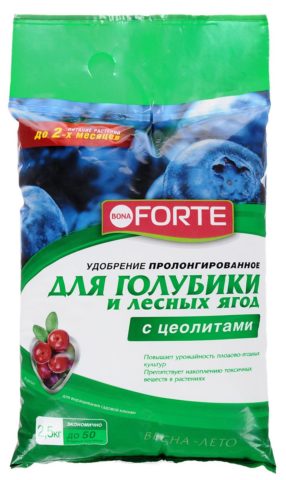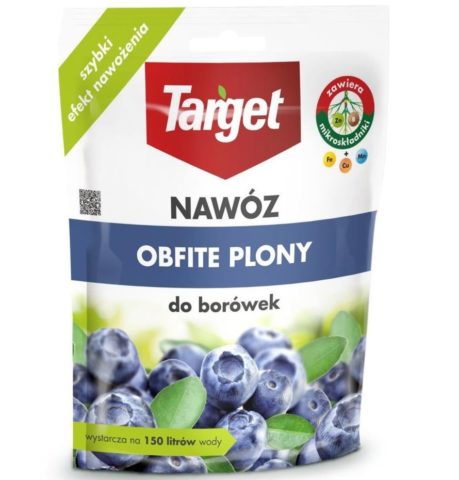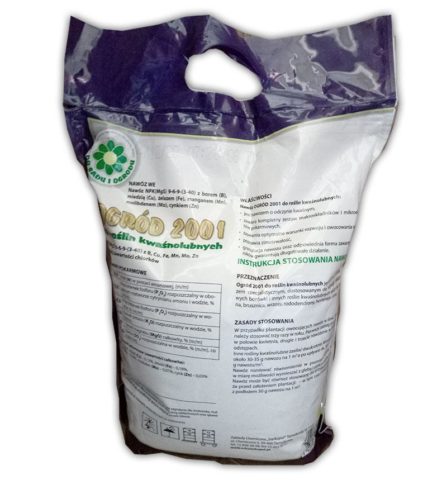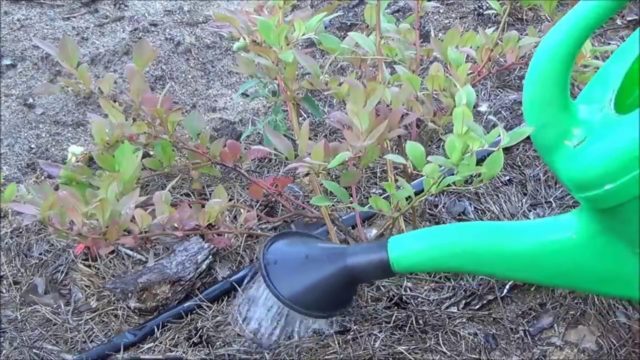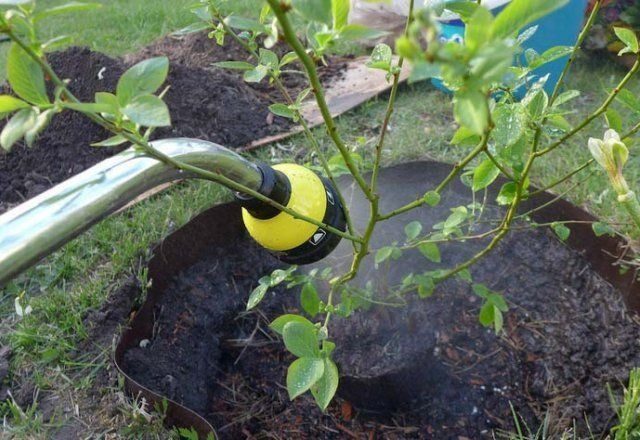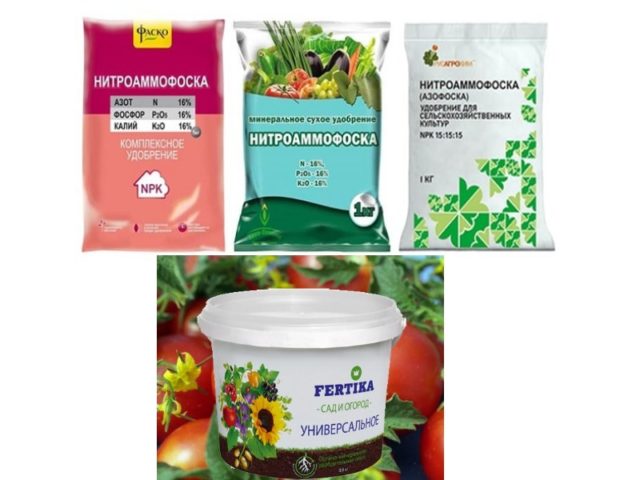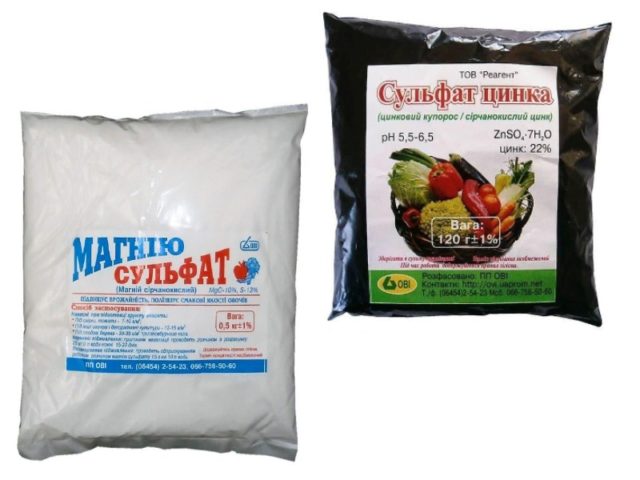Content
Blueberry cultivars are becoming more and more popular year after year for cultivation both on industrial plantations and in small amateur garden plots. The most important role in the process of caring for this shrub is given to the application of fertilizers. Knowing how to feed garden blueberries in spring, summer and autumn, and how to do it correctly, you can create optimal conditions for its development and growth. Then the culture will undoubtedly "thank" for this with a healthy appearance and regular abundant harvests.
Do I need to fertilize blueberries
Garden blueberry is one of those berry bushes whose need for additional nutrient supplementation is especially high. Most often, the natural composition of the soil on the site does not contain in sufficient quantities all the macro- and microelements required by blueberries - therefore, they must certainly be introduced artificially. At the same time, violation of the rules and proportions during the introduction of fertilizers results in a slowdown in growth and a weakening of the plant, a drop in yield, the appearance of pests and diseases.
What trace elements do blueberries need?
For full development, abundant fruiting and the provision of vitamins for blueberries, a soil rich in a set of certain chemicals and microelements is needed.
Nitrogen is vital for blueberries during growth and ovary formation. Substances containing nitrogen are introduced into the soil immediately before planting the bush, and then fertilize the plant with them 2-3 times during spring and early summer.
Starting from the period when buds begin to bloom, blueberries especially need fertilizing containing potassium and phosphorus. Potassium affects the formation of a plant's protection against pests, resistance to a lack of moisture. Phosphorus increases the vitality of the shrub, helps to increase the yield.
In the summer, when the berries are ripe, when applying top dressing, it is advisable to focus on potash fertilizers. You can also use complex formulations containing trace elements (primarily magnesium, which contributes to the process of photosynthesis in the leaves). This will help to achieve sweetness and good quality fruit. In addition, for successful growth and development, blueberries cannot do without calcium, manganese, iron, copper, sulfur, zinc, boron, molybdenum, sodium.
In the fall, blueberries also need sufficient nutrients and trace elements such as magnesium and zinc. At this time of year, she will have to recover from fruiting and prepare for winter. In addition, at this stage, vegetative buds are laid for the next season, respectively, the autumn application of fertilizing to the soil will affect the yield next year. The presence of potassium in the soil is especially necessary in order for the plant to successfully endure winter frosts.
How does a lack or excess of nutrients affect yields?
In order for garden blueberries to successfully develop and consistently give high, high-quality yields, it is decisive to maintain the balance of three elements: nitrogen, potassium and phosphorus.
An excess of nitrogen in the soil at the end of the season can lead to a deterioration in the quality of the berries, excessive growth of shoots, which are likely to freeze in winter, inhibition of the growth of flower buds, which will negatively affect fruiting next year. The size of the fruits will decrease, their ripening will be delayed. At the same time, the lack of nitrogen will significantly slow down the growth of the bush, and the ripening of the berries will also occur slowly.
The content of potassium and phosphorus in the soil in excess of the norm can cause plant rot. The deficiency of these substances will manifest itself in a decrease in yield and a deterioration in the quality of fruits, their critical shortage can lead to the weakening and death of the bush.
In relatively large quantities, blueberries require magnesium, calcium and sulfur. Without these substances, normal fruiting of this culture is also impossible, but they are introduced into the soil periodically, only as needed.
You should be especially careful with manganese, copper, boron, sodium. As a rule, the soil contains enough of them to meet the needs of garden blueberries. Excessive concentration can be toxic to the plant.
When do you need to fertilize blueberries?
You can determine the lack or excess of a certain substance in the soil under blueberries by carefully examining the plant itself:
Cause | How does it appear on blueberry leaves |
Lack of nitrogen | They turn yellow, starting from the edges, then acquire a reddish tint. Shrub growth slows down. Young shoots turn pinkish. |
Excess nitrogen | They acquire a rich dark green color. The bushes are very thick, tall. |
Lack of phosphorus | They are compacted, they are closely pressed to the stem. Over time, they acquire a purple hue, clearly visible in bright light. |
Lack of potassium | The upper parts of the plates die off, the edges warp |
Lack of calcium | The plates are deformed, a yellow rim appears along the edge. |
Lack of magnesium | On older leaves, the edges are bright red, while the central part remains green. |
Boron shortage | The upper parts of the plates become bluish. Growth stops abruptly. |
Lack of iron | Young leaves turn yellow between the veins. |
Lack of manganese | Yellowing between the veins, later the yellow parts dry and die off. |
Zinc deficiency | Stop growing. They acquire a lemon yellow color. |
Lack of sulfur | Yellowish-white spots all over the plate. Subsequently, they whiten completely. |
Mineral and complex fertilizers for garden blueberries
To provide garden blueberries with additional nutrition at different times of the season, mineral nitrogen or potassium-phosphorus fertilizers will be needed. To feed the plant in spring (before flowering), complex formulations containing the three above substances are perfect.At the same time, it is not necessary to make the mixtures ourselves - you can purchase ready-made "cocktails" for garden blueberries, including those whose composition is enriched with the necessary trace elements and vitamins for this culture, and may also contain growth stimulants and soil oxidants.
Among the most famous and beloved by gardeners of ready-made complex dressings:
- Fertilizer "Good Power" for blueberries and wild berries - a liquid composition that combines three main macronutrients necessary for these plants (nitrogen, phosphorus and potassium), 7 microelements, as well as vitamins B1 and PP. It also includes a growth stimulant - succinic acid. The consumption of the composition is small: 1 bottle is designed for 100 buckets of water. They are introduced by watering, as well as spraying shrubs in the spring at the stages of the appearance of buds, ovaries and the formation of berries. The use of "Good Power" improves the survival rate of a young bush, stimulates the growth of shoots, and significantly increases the yield.
- «Bona forte»(Fertilizer for blueberries and forest berries with bioavailable silicon) - granular fertilizing with prolonged action. In addition to nitrogen, phosphorus and potassium, it contains silicon as a growth stimulator and plant immunity activator, as well as magnesium and a number of trace elements in a chelated form. Heals the root system, promotes the growth of shoots, the formation of ovaries, increases the yield and sugar content of fruits. It is introduced into the soil under blueberries 2-3 times a year - it is distributed over the surface of the soil and loosening is performed.
- «Target obfite plony»(Target Generous harvests) - complex fertilizer for blueberries in the form of granules. It contains nitrogen, phosphorus, potassium and 6 microelements. Promotes the acceleration of the growth rate of bushes, the growth of green mass, the formation of large and sweet berries. It is recommended to apply it in the form of a solution (5 g per 5 l of water) under the root of the plant, once every 2-3 weeks, from April to July.
- AVA - an innovative long-acting complex top dressing, close in mineral composition to volcanic lava. AVA capsules, granules or powder contain phosphorus and potassium, as well as 11 trace elements, some of which are present in micro doses. This top dressing is optimal for meeting the vital needs of plants of any type, helping them to develop more actively, endure winters more easily, and get sick less. It also has a positive effect on the size, taste and preservation of the fruit. The AVA fertilizer does not contain nitrogen, but it helps create conditions in the soil for the development of bacteria that extract it from the air. The dose recommended for feeding blueberries at any time of the year is 5 g per 1 bush (add to the surface layer of the soil, then slightly loosen it). In the summer, you can water the plants by dissolving 4 g of the composition in 1 l of water, or spray them with foliage in a lower concentration (2 g per 1 l).
- Ogrod 2001 for blueberries - granular food specially adapted for plants growing on acidic soils. In addition to nitrogen, potassium and phosphorus, it contains 7 trace elements necessary for these crops. After the introduction of this composition into the soil, the plants actively develop and bear fruit, their winter hardiness increases. Apply dry fertilizer 3 times during the season. The first feeding is carried out in April, each subsequent feeding is carried out with an interval of 30 days. Granules (35 g per 1 m2) are scattered on pre-loosened soil in near-trunk circles, then poured abundantly with water.
Fertilization methods for garden blueberries
To feed blueberries correctly, you should not only choose the right fertilizer, but also apply it at the right time in the most optimal way for the plant, calculating the dosage exactly.
There are several ways to provide the plant with additional nutrition during the season:
- add dry fertilizer in the form of granules or powder directly to the soil;
- water the bushes with a nutrient dissolved in water;
- spray the leaves and shoots with a fertilizer solution.
In the first two cases, root feeding is carried out, since substances and trace elements are absorbed from the soil by the roots of the plant. This is the main method for fertilizing blueberries.
General recommendations and rules for root feeding are as follows:
- it is advisable to carry out the procedure in the morning or in the evening - it is allowed in the afternoon, but in cloudy weather;
- the soil under the plants must first be well moistened: if there has been no rain for some time, then a day or two before adding fertilizer, the blueberry bushes must be watered;
- within a radius of 15-20 cm from the trunk circle, lay a shallow groove, where top dressing should be applied - pour in a liquid solution or scatter dry granules over the soil surface;
- close up the fertilizer by loosening the soil;
- Pour plenty of clean water over the blueberries.
Foliar dressing involves the supply of nutrients through the leaves. Their source is a liquid solution sprayed over the surface of the plates. This simple method is most often used in summer, during the fruiting season of blueberries. It is most effective when it is necessary to fill the deficiency of useful elements as soon as possible - for example, if a large amount of them was washed out of the soil as a result of prolonged rains, or signs indicating a lack of something vital are visible on the plant.
Features of making foliar dressings:
- the finer the composition is sprayed, the higher its concentration will be on the surface of the leaves;
- determining the proportion of dilution of the drug for feeding, it is imperative to adhere to the instructions, observe the expiration dates;
- since blueberries have very dense leaves, often also covered with a waxy coating, it is advisable to add a substance to the solution that promotes adhesion of its particles to the surface of the plates (liquid soap).
Terms and rules for feeding blueberries from spring to autumn
You should be aware that annual blueberry bushes do not need to be fed additionally. Artificial introduction of nutrients begins from the second year of their life. Mature shrubs (6 years and older) need more fertilizer than young plants.
Feeding blueberries in spring, summer and autumn has its own characteristics and rules. They are clearly and systematically reflected in the material
How to fertilize garden blueberries in spring
In spring, blueberries need to be fertilized in order to stimulate their growth and development.
Top dressing during this period, as a rule, is divided into two stages:
- early spring (late March and mid-April) - before sap flow begins and the buds swell;
- flowering time of the plant (May-June).
How to feed blueberries for growth
At this stage, blueberries require mineral fertilizers with a high content of three key nutrients - nitrogen, phosphorus and potassium.
You can use complexes that combine all three of the listed substances (Nitroammofoska, Fertika-Universal).
The optimal simple mineral dressing for saturating the soil with nitrogen is ammonium sulfate. For these purposes, ammonium nitrate and urea (urea) are also suitable. The norm of nitrogen fertilizers per year for 1 adult blueberry bush is 50-70 g. Before the buds swell, half the dose recommended for the entire season is introduced into the soil. The top dressing is dissolved in water and applied at the root, avoiding contact with the leaves.
An adult blueberry bush also needs 30-50 g of phosphorus and 30-40 g of potassium per year. Superphosphate or double phosphate will help nourish the plant first in the required amount. The need for a second can be satisfied with the help of potassium sulfate or potassium salt. In April, 1/3 of the annual rate of both substances is added to the soil under the blueberries.
How to feed blueberries during flowering
During this period, blueberries spend a lot of energy on the formation of buds and ovaries. She needs the same minerals as in the previous stage, but in a different ratio.
The second portion of nitrogen fertilizers, 30%, should be fed to blueberries in the first decade of May. The last 20% should be applied to the soil at the beginning of June.
Also, at the beginning of June, the plant should receive another 1/3 of phosphorus and potassium fertilizers.
At the budding stage, you can also carry out foliar feeding with nutrients. For her, it is most convenient to prepare a solution based on a ready-made complex composition ("Good Power"), and then abundantly spray the bushes.
How to feed garden blueberries in summer
Top dressing of blueberries in summer, at the end of June or at the beginning of July, aims to ensure the filling of berries and abundant ripening of the crop. At this stage, the plant will need potassium and phosphorus - the remaining 1/3 of the fertilizers containing these substances are added to the soil.
Also in June and July, you can feed blueberries with a nutrient mixture from a set of micronutrients that it lacks. However, this should be done only when such a need really exists (this can be determined by the appearance of the plant or using leaf analysis).
How to feed blueberries in autumn
The last time this season is to feed the blueberries in August and early September, after the harvest has been completed. The goal is to strengthen the plant and increase its frost resistance.
If in previous periods all dressings were made in the required quantities, then at this time it will be enough to additionally feed the plant with magnesium sulfate (15 g) and zinc sulfate (2 g).
When feeding blueberries in late summer and especially in autumn, nitrogen fertilizers are not used. They stimulate plant growth, building up green mass, which is completely unnecessary before the onset of cold weather. The shrub must have time to prepare for winter, otherwise it is threatened with freezing.
What can not be fed blueberries
It is categorically not to be used as a fertilizer for blueberries:
- organic feeding;
- products containing chlorine or nitrates.
You should also not feed this culture with compositions based on folk recipes suitable for other berry plants (wood ash, eggshells, lime, dolomite flour, various herbal infusions). The listed fertilizers are not suitable for blueberries, as they cause strong alkalization of the soil.
The same goes for the yeast-based feed mentioned in some sources. The benefits of it are very doubtful, since yeast in large quantities absorbs the oxygen necessary for the plant, and also competes with other useful soil flora.
Conclusion
In order to properly feed garden blueberries in spring, summer and autumn, you should know the need for what substances the plant experiences during these periods, when, how and in what quantity they should be added. Depending on the situation, additional nutrition should be introduced under the roots or through the leaves, having correctly prepared the mixture or calculating the proportion of the "cocktail" of minerals and trace elements. It should always be remembered that violation of the recommendations prescribed in the instructions for fertilizers, incorrect dosages or mistakes in the choice of fertilizing can significantly harm the plant.At the same time, adherence to all the rules of agricultural technology when fertilizing blueberries, along with measures for proper care for it, will most likely guarantee a good yield and sweet, large berries.
